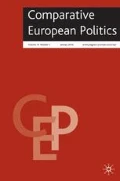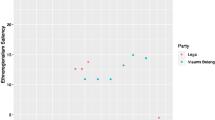Abstract
The chapter addresses the question of the discontinuity and continuity in Italian discourse about European integration after WW2. On the one hand, discontinuity is shown by the changing approach to EU by Mr S. Berlusconi (three times Prime Minister from 1994 to 2011) and the leaders of the ruling centre-right coalitions of the 2nd Italian Republic starting in 1992 as well as by the effects of the economic crisis in underpinning populism. On the other hand, by a historical institutionalist approach, the author stresses that the weight of the anti-fascist origins of the Europeanist streams, the rich cultural heritage and the lack of any practical nationalist alternative explain the comparatively high rate of continuity in Italian support for EU integration.
Similar content being viewed by others
Notes
Drafted to correspond to the expectations raised by the UN San Francisco Charter, the Article 11, stating Italy’s availability to delegate, under conditions of parity, parts of its sovereignty to international organizations aiming at peace, allowed for 60 years of integration of the European treaties in the Italian institutional system, without having to go through the constitutional amendments as in France or the rulings of the Constitutional Court as in Germany. See: Costituzione della Repubblica Italiana, Art 11, Rome 2007.
G. Napolitano, future President of the Republic, is the author of the parliamentary resolution on foreign policy in 1978 by which the PCI explicitly recognized for the first time the EC and NATO, as part of the conciliation between PCI and DC (known as the ‘historic compromise’) and the need to consolidate and stabilize Italian democracy, affected by domestic terrorism (the ‘Moro affair’ occurred in 1978) and the economic crisis that followed the oil shocks. There were deep roots, namely, the awareness of the importance of European integration, which had matured during the 1960s and 1970s. See on this point: A. Ranney and G. Sartori, Eurocommunism. The Italian Case, Washington, 1978 and G.R.Urban, Eurocommunsm. Its Roots and Future in Italy and elsewhere, Washington, 1978 and G. Napolitano-E.Hobsbowm, Dialogue about the PCI, London 1974. See also: Donald Sassoon, Contemporary Italy, London, Longman, 1986; D. La Palombara, Democracy Italian Style, Yale University Press 1987 et M. L. Salvadori, La sinistra nella storia d’Italia, Bari, Laterza, 1999. E. Berlinguer has given an interview to the ‘Corriere della sera’, regarding ‘NATO as a protective shield for the PCI’s reforms’, which was followed by a matching parliamentary resolution, the first since 1947 that was elaborated and voted by all the democratic parties.
Even if, contrary to the far left in France and other countries, key figures such as R. Rossanda the ‘Manifesto’ and even A. Negri have argued in the French press in favor of ‘Yes’ in the French referendum of 2005.
But in their search for a European legitimacy through the admission to the EPP, the right does not dare to take an explicitly anti-EU position.
The proceedings were published in K. Nikolaidis and J. Lacroix (eds.) European Stories, Oxford University Press, Oxford 2011, and the two chapters on Germany and Italy were, respectively, written by J. Müller and M. Telò.
A similar interpretation is also developed by M. Telò and R. Seidelmann in ‘Where is Germany going?’ Special issue of the Journal Europa-Europe, 1999.
Which does not prevent the outbreak of occasional conflicts and serious failures in several policy areas: the Lisbon Strategy, CAP, environment, media, immigration …
This article has been written in July 2011. However, the withdrawal of the Berlusconi’s government (November 2011) and the arrival in office of Monti’s government is providing some additional empirical evidence confirming the thesis of the prevailing ‘continuity’ of Italy’s European policy: see, for example, the Senate Resolution of 25 January 2012, voted by an unprecedented majority of PDL, PD and Center parties (Mozione unitaria sulla politica Europea) and also the convergence of all main Italian parties on the Intergovernmental treaty proposed by Germany as a ‘Fiscal compact’ and signed by 25 European Union’s member states.
References
Agnelli, G. and Cabiati, A. (1989) Federazione europea o lega delle Nazioni. Torino, Italy: ETL.
Amato, G. (2001) Génèse et destinée de la constitution européenne. Bruxelles, Belgium: Bruylant.
Cacciari, M. (1994) Geofilosofia dell’Europa. Roma, Italy: Adelphi.
Carli, G. (1993) Cinquant’anni di vita italiana. Bari, Italy: Laterza.
Castronovo, V. (1977) Giovanni Agnelli. Torino, Italy: Einaudi.
Chabod, F. (1961) Storia dell’idea d’Europa. Bari, Italy: Laterza.
Chenaux, P. (1990) Une Europe vaticane? Entre le plan Marshall et les traités de Rome. Bruxelles, Belgium: Editions Ciaco.
Croce, B. (1932) Storia d’Europa del XIX secolo. Bari, Italy: Laterza.
De Felice, F. (2003) L’Italia Repubblicana. Torino, Italy: Einaudi.
De Giovanni, B. (1992) L’ambigua potenza dell’Europa. Napoli, Italy: Guida.
Duggan, J. (2008) La forza del destino. Roma/Bari, Italy: Laterza.
Eco, U. (2000) La lingua perfetta. Bari, Italy: Laterza.
Fabbrini, S. and Piattoni, S. (eds.) (2008) Italy in the European Union. Redefining National Interest in a Compound Polity. Plymouth, UK: Rowman and Littlefield.
Garton, A.T. (1993) In Europe’s Name: Germany and the Divided Continent. London: Vintage.
Gramsci, A. (1975) Quaderno sul Machiavelli. Torino, Italy: Einaudi.
Keohane, R. (ed.) (1993) After the Cold War. Princeton, NJ: Princeton University Press.
Leopardi, G. (1972 [1830]) Rimembranze. Milano, Italy: Mondadori.
Machiavelli, N. (2005 [1513]) The Art of War. Chicago, IL: University of Chicago Press.
Magris, C. (1986) Danubio. Milano in English, Danube: Harvill Press, 2001.
Martino, A. (1994) La rivolta liberale. Milano, Italy: Sperling & Kupfer.
Morlino, L. (2005) Assessing the Quality of Democracy, Theory and Empirical Analysis. Baltimore: Johns Hopkins University Press.
Napolitano, G. (1992) America ed Europa dopo il 1989. Roma, Italy: Laterza.
Napolitano, G. (2002) Europa politica. Roma, Italy: Laterza.
Padoa Schioppa, T. (2004) EU as a Gentle Power. London: Federal Trust.
Pierangelo Schiera e Gabriella Zarri and Prosperi, A. (eds) (2007) Chiesa cattolica e mondo moderno. Il mulino: Bologna.
Pistone, S. (ed.) (1975) L’idea di unificazione europea dalla prima alla seconda guerra mondiale. Torino, Italy: Fondazione Einaudi.
Prosperi, A. (1996) Tribunali della coscienza. Inquisitori, confessori, missionari. Torino, Italy: Einaudi.
Prosperi, A. (1999) Il Concilio di Trento e la Controriforma. Trento, Italy: UCT.
Prosperi, A., Schiera, P. and Zarri, G. (1996) Chiesa Cattolica e mondo moderno. Bologna, Italy: Il Mulino.
Ruggie, J. (ed.) (2008) Embedding Global Markets. Aldershot: Ashgate.
Rusconi, G.E. (1993) Se cessiamo di essere una nazione. Torino, Italy: Einaudi.
Rusconi, G.E. (2003) Germania, Italia, Europa: dallo stato di Potenza alla Potenza civile. Torino, Italy: Einaudi.
Schmidt, V. (2006) Democracy in Europe. Oxford: Oxford University Press.
Scoppola, P. (1977) La proposta politica di De Gasperi. Bologna, Italy: Il Mulino.
Spinelli, A. (1975) Il progetto europeo. Bologna, Italy: Il Mulino.
Spinelli, A. (1986) Discorsi al parlamento europeo,1976–1986. Bologna, Italy: Il Mulino.
Spinelli, A. (1989) Una strategia per gli Stati Uniti d’Europa. Bologna, Italy: Il Mulino.
Telò, M. (1989) La SPD tra tradizione socialista e progetto europeo. Roma, Italy: Editori Riuniti.
Telò, M. (2006) Germany and the EU, between Civilian Power and Realism. A Non-German Point of View. In: F. Pfetsch and A. Lessing (eds.) Germany Re-united and the European Union. Jerusalem, Israel: Forum Hebrew University.
Tremonti, G. (2008) La paura e la speranza. Milano, Italy: Mondadori.
Tuccari, F. (ed.) (2002) Il governo Berlusconi. Bari, Italy: Laterza.
Veneziani, M. (2002) La cultura della Destra. Roma, Italy: Laterza.
Weiler, J.H.H. (2007) L’Europe Chrétienne. Paris, France: CERF.
Author information
Authors and Affiliations
Rights and permissions
About this article
Cite this article
Telò, M. Italy's interaction with the European project, from the First to the Second Republic: Continuity and change. Comp Eur Polit 11, 296–316 (2013). https://doi.org/10.1057/cep.2012.45
Published:
Issue Date:
DOI: https://doi.org/10.1057/cep.2012.45




